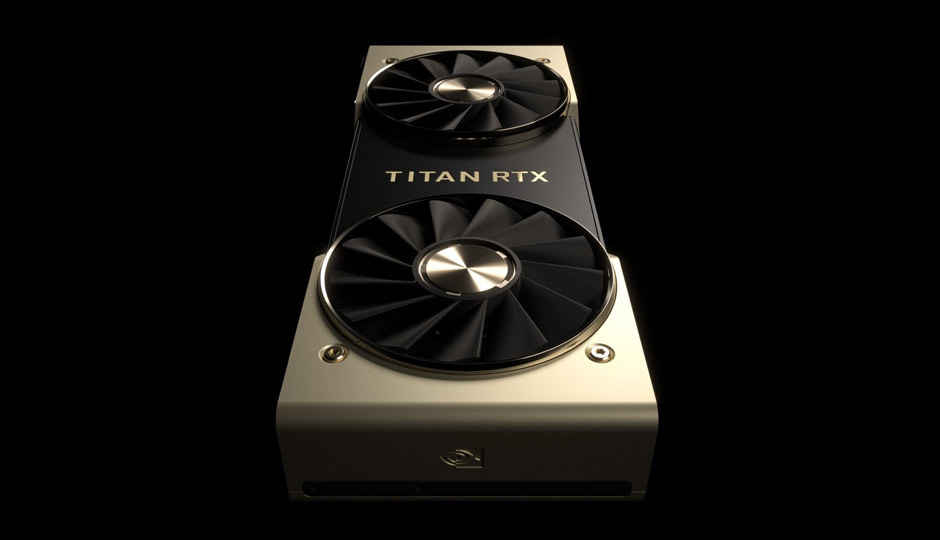NVIDIA unveils $2,500 RTX TITAN Turing-based graphics card with 24 GB of VRAM

The flagship SKU in the Turing-based RTX 2000 series packs a wallop with 130 TFLOPS of Tensor perfor
Most of the top SKUs in NVIDIA’s RTX 2000 series of cards are out with their announcement at GAMESCOM 2018. What remained was the flagship TITAN card and the mid-range 2060 and 2050 graphics cards. Most of us expected the TITAN RTX to be unveiled at CES but NVIDIA decided to make good of the hype-vacuum and unveil the TITAN RTX today. Like previous TITAN cards, the TITAN RTX is aimed at workstation loads but it’s very likely that we will see it on gaming rigs in the coming months. The only thing holding people back is the $2,500 price tag which is, surprisingly, lower than the previous TITAN V’s price tag of $2,999. Let’s take a look at the specifications.
|
NVIDIA RTX TITAN Specifications |
||||
|
Titan RTX |
Titan V |
RTX 2080 Ti |
Tesla V100 |
|
|
CUDA Cores |
4608 |
5120 |
4352 |
5120 |
|
Tensor Cores |
576 |
640 |
544 |
640 |
|
Core Clock |
1350MHz |
1200MHz |
1350MHz |
? |
|
Boost Clock |
1770MHz |
1455MHz |
1635MHz |
1370MHz |
|
Memory Clock |
14Gbps GDDR6 |
1.7Gbps HBM2 |
14Gbps GDDR6 |
1.75Gbps HBM2 |
|
Memory Bus Width |
384-bit |
3072-bit |
352-bit |
4096-bit |
|
Memory Bandwidth |
672GB/sec |
653GB/sec |
616GB/sec |
900GB/sec |
|
VRAM |
24GB |
12GB |
11GB |
16GB |
|
L2 Cache |
6MB |
4.5MB |
5.5MB |
6MB |
|
Single Precision |
16.3 TFLOPS |
13.8 TFLOPS |
14.2 TFLOPS |
14 TFLOPS |
|
Double Precision |
0.51 TFLOPS |
6.9 TFLOPS |
0.44 TFLOPS |
7 TFLOPS |
|
Tensor Performance (FP16 w/FP32 Acc) |
130 TFLOPS |
110 TFLOPS |
57 TFLOPS |
112 TFLOPS |
|
GPU |
TU102 |
GV100 |
TU102 |
GV100 |
|
Die Size |
754mm2 |
815mm2 |
754mm2 |
815mm2 |
|
Transistor Count |
18.6B |
21.1B |
18.6B |
21.1B |
|
TDP |
280W |
250W |
260W |
250W |
|
Form Factor |
PCIe |
PCIe |
PCIe |
PCIe |
|
Manufacturing Process |
12nm |
12nm |
12nm |
12nm |
|
Architecture |
Turing |
Volta |
Turing |
Volta |
|
Launch Date |
12/2018 |
12/07/2017 |
09/20/2018 |
Q3'17 |
|
Price |
$2499 |
$2999 |
$1199 |
~$10000 |
The TITAN RTX uses the same TU102 as the RTX 2080 Ti which means they’re both the same chip but given how the RTX 2080 Ti seems to have fewer active CUDA cores, we can surmise that it uses a slightly cut down version of the TU102 while the TITAN RTX uses all of it. The TITAN RTX even has a slightly better boost clock than the 2080 Ti and more thermal headroom as well.
From a design perspective, the TITAN RTX follows the new twin-blower cooler that the RTX series introduced. There are no openings on the rear side of the card so it’ll be interesting to see how this design fares in a NVLink configuration. Since TITAN cards are often used in multi-GPU configurations, the cooling on the cards makes a huge difference. The only thing different here seems to be the golden tinge that the TITAN RTX has. NVIDIA is calling it, T-Rex.
Mithun Mohandas
Mithun Mohandas is an Indian technology journalist with 10 years of experience covering consumer technology. He is currently employed at Digit in the capacity of a Managing Editor. Mithun has a background in Computer Engineering and was an active member of the IEEE during his college days. He has a penchant for digging deep into unravelling what makes a device tick. If there's a transistor in it, Mithun's probably going to rip it apart till he finds it. At Digit, he covers processors, graphics cards, storage media, displays and networking devices aside from anything developer related. As an avid PC gamer, he prefers RTS and FPS titles, and can be quite competitive in a race to the finish line. He only gets consoles for the exclusives. He can be seen playing Valorant, World of Tanks, HITMAN and the occasional Age of Empires or being the voice behind hundreds of Digit videos. View Full Profile






